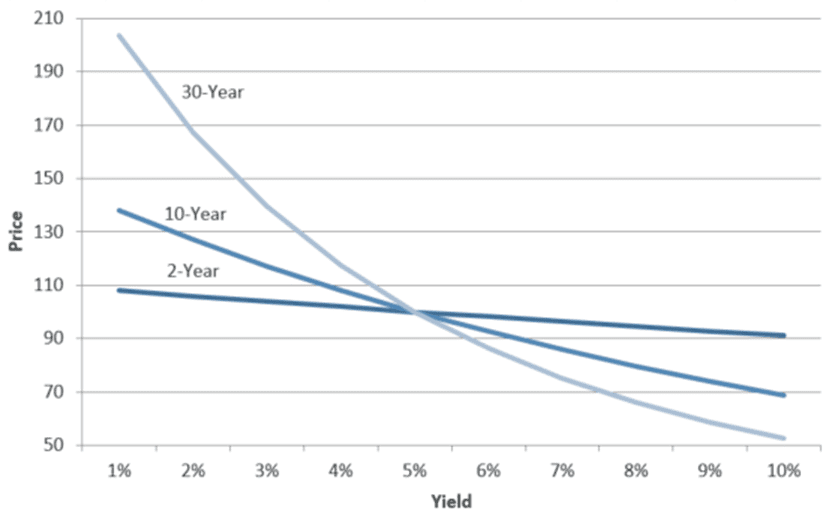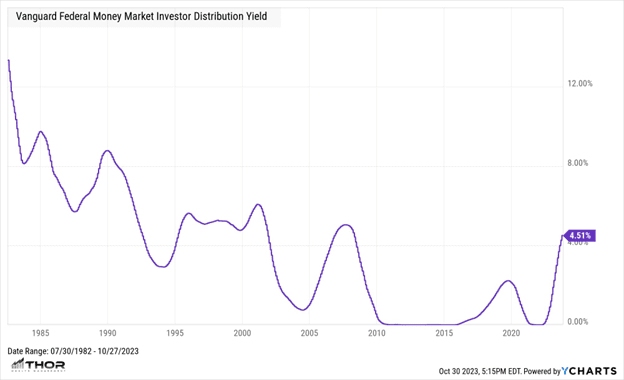Should I Put Cash Into a Money Market Fund?
Blog post
11/08/23As the Federal Reserve has raised the targeted federal funds rate, money market funds have been gaining attraction from investors. Since the beginning of 2022, interest rates have been on the rise which has resulted in some horrific returns in the bond market. With some money market funds yielding over 5% today, is it a good idea to put money into such an investment instead of bonds and what are the downsides of making this kind of move?
Reinvestment Risk
This is the first and most important type of risk when investing in short-term money market funds. Reinvestment risk is simply the risk that your coupon (interest) and original investment (principal) will potentially not be reinvested in the future at a rate equal to the current rate. It is the opposite of interest rate risk when rates are going up. A money market fund invests in very short-term bonds and because of that, their reinvestment risk is very high. If the Federal Reserve were to reverse course and lower interest rates, you potentially would be stuck reinvesting your proceeds (interest and principal) into lower interest-bearing investments. Short-term rates were close to zero for almost a decade between 2010 and 2020. On the flip side, if you invested in longer maturity/duration bonds, your investment (principal) would be locked into that higher yield for longer. The money market investment might look attractive today at 5% but if the Federal Reserve followed a similar course to previous interest rate cycles, you potentially could be stuck with an investment with a much lower yield in the future.
Bond Upside
Bonds have an inverse relationship with interest rates. When rates go down, bond prices generally go up. Additionally, duration is a measure for the sensitivity of the bond price to changes in interest rates. The longer the duration of your bond investment, the more upside you will have if rates go down. For example, if you buy a 10-year treasury bond at 5%, and rates go down, that same 5% bond will go up in price. Why is that? Think about it in the simplest of terms. If you bought a bond six months ago for $100 that is paying a 5% yield and since that time interest rates have gone down to 3%, why would you sell that same bond for $100 when the market is currently only offering a 3% coupon? You wouldn’t! The bond would be priced at a premium (more than $100) to compensate you for that difference in yield. How much of an increase? The increase in value would be dependent on the duration of the bond. The longer the duration, the more the bond will increase in value. Assuming you bought a bond with a 10-year maturity (10-year duration), the bond value would go up by approximately 10% for every 1% decrease in interest rates.
Higher Starting Rates Act as a Cushion
As interest rates go up, the downside effect of even higher rates on the price of that bond lessens. Why is that? The interest you are receiving from the bond increasingly offsets the effects of higher rates. The term for this relationship is bond convexity.

You can see in the chart above that each of the different maturities represented by each of the three lines has a different slope. The downward slope of the line for the 30-Year bond is much more drastic when rates are low in comparison to the slope of the 2-Year bond which is much more subtle. As the yield increases and the lines move towards the right side of the graph, the downward slope for the longer maturities flattens out faster. In a simple example, if the yield on a 10-year bond is 10%, you will have a 10% cushion to offset rising rates. If the price of the bond drops 10%, it would take one year of interest to recover that loss. Compare that scenario with the same bond but a lower starting interest rate; 10-year bond with a 1% yield. To make up for that same 10% loss in the price of the bond, it would take 10 years of a 1% interest coupon to recover that same loss. Additionally, going back to the reinvestment risk, if rates continue to rise, you potentially could take advantage of the higher rates and reinvest any proceeds (interest and principal) into a bond with an even higher yield.
Summary
In a vacuum, money market investments yielding close to 5% might seem attractive. This is especially true considering short-term rates have only eclipsed 2% once over the past 15 years (see below).

Even with a low-risk investment like money markets, like all investments, there are many considerations and risks you should decipher before investing. Depending on your individual situation, putting some cash into a money market might make sense but it could also be setting yourself up for a headache in the future.
If you have questions and would like to talk with us further, please call us at 513-271-6777. For more THOR reading, click here to go to the Blogs and Market Updates section on our website.
Follow us on social media: